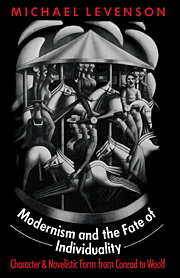Book contents
- Frontmatter
- Contents
- Preface
- Acknowledgements
- 1 Two cultures and an individual: Heart of Darkness and The Ambassadors
- 2 Liberalism and symbolism in Howards End
- 3 Justification, passion, freedom: character in The Good Soldier
- 4 Form's body: Lewis's Tarr
- 5 “The passion of opposition” in Women in Love: none, one, two, few, many
- 6 From the epic To the Lighthouse
- Notes
- Index
6 - From the epic To the Lighthouse
Published online by Cambridge University Press: 16 September 2009
- Frontmatter
- Contents
- Preface
- Acknowledgements
- 1 Two cultures and an individual: Heart of Darkness and The Ambassadors
- 2 Liberalism and symbolism in Howards End
- 3 Justification, passion, freedom: character in The Good Soldier
- 4 Form's body: Lewis's Tarr
- 5 “The passion of opposition” in Women in Love: none, one, two, few, many
- 6 From the epic To the Lighthouse
- Notes
- Index
Summary
Woolf enters this book as she entered the lists of the modern novel, as a woman among a crowd of men and as a literary revolutionary writing after the first wave of revolution had passed. These two conditions, her sex and her age, threatened to make her the modernists' unwanted daughter, at once belated and premature – belated because she seemed doomed to repeat the rituals of aesthetic revolt, premature because she was doomed to live before the epoch of the daughters. To the Lighthouse, which becomes finally a vindication of the rights and gifts of the daughter, does so by revealing her as neither belated nor premature but as a timely alternative to the conceptions of character that had dominated English modernism.
It is well to remember that early twentieth-century definitions of the new aesthetic favored a sexual metaphor which cast women as major contributors to precipitous cultural decline. One thinks, for instance, of Irving Babbitt's claim that the “predominance of the feminine over the masculine virtues … has been the main cause of the corruption of literature and the arts during the past century”; of T. E. Hulme's appeal for a new poetry of “virile thought”; or of Joyce's remark that “T. S. Eliot ends [the] idea of poetry for ladies.”
- Type
- Chapter
- Information
- Modernism and the Fate of IndividualityCharacter and Novelistic Form from Conrad to Woolf, pp. 166 - 216Publisher: Cambridge University PressPrint publication year: 1991



